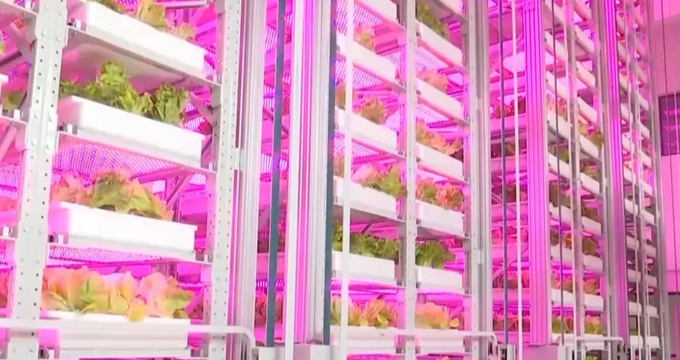November 27, 2025 | 18:03 GMT +7
November 27, 2025 | 18:03 GMT +7
Hotline: 0913.378.918
November 27, 2025 | 18:03 GMT +7
Hotline: 0913.378.918

China's vertical farm.
China has unveiled its first domestically developed unmanned vertical plant factory in Chengdu, Sichuan Province. Developed by the Institute of Urban Agriculture under the Chinese Academy of Agricultural Sciences, the 20-storied vertical farm is a first of its kind.
Vertical farming is often considered a promising and innovative approach to address certain challenges in agriculture. Allowing for the cultivation of crops in stacked layers, maximizes the use of vertical space.
This is particularly beneficial in urban areas where land is limited. It offers the potential to produce more food per square meter compared to traditional horizontal farming.
But in comparison to horizontal farming, there is the issue of plants getting an adequate amount of sunlight and water when crops are grown vertically. The team that developed this 20-storied art of specimen found a solution.
The team at the Institute of Urban Agriculture (IUA), Chinese Academy of Agricultural Sciences (CAAS) deployed robots that can grow and harvest a crop of lettuce in just 35 days, claim the researchers in a report.
This is possible due to an artificial intelligence-based control system. This control system utilizes advanced technologies and algorithms to monitor, analyze, and adjust key environmental variables within the vertical farming facility.
The facility utilizes advanced plant light formulas to improve light efficiency, overcoming challenges related to low light efficiency and high energy consumption.
"We can combine different amounts of red, blue, yellow, near-ultraviolet and near-infrared lights during different stages of the plant's lifecycle," said Wang Sen, a researcher at the IUA. "We have built a database of 1,300 combinations for 72 types of crops."
The vertical farming system enables year-round, continuous production of green food in multi-story structures, addressing issues like stable local food supply in urban areas and expanding cultivation in challenging environments.
With the ability to produce more than 10 harvests of green vegetables annually, the system enhances land utilization efficiency and conserves resources, providing a sustainable solution for future agriculture.
The research team led by Wang has found no significant difference between lab-grown plants and those from traditional farms. Indoor farms, with the ability to produce vegetables faster, are considered ideal for urban areas, wastelands, and deserts.
It also serves as a breeding accelerator, reducing the breed time of wheat, cotton, and soybean plants by at least 50 percent. The researchers are discussing with companies like Foshan NationStar Optoelectronics to commercialize their innovative vertical farming technology.
(interestingengineering)

(VAN) A new study reveals how the simultaneous effects of ocean acidification, salinity and loss of oxygen are making the world more fragile.

(VAN) Hopes are growing that the creation of the first 3D turkey gut model could be a turning point in the battle against the virulent blackhead disease.

(VAN) Tyson, America’s biggest meat supplier, plans to shutter one of its largest beef processing plants as the industry continues to struggle with low cattle supplies and political pressure from Washington.

(VAN) New FAO study shows how digital solutions are empowering farmers and fishers to prevent losses and build resilient agrifood systems.

(VAN) Brazil's COP30 presidency pushed through a compromise climate deal on Saturday that would boost finance for poor nations coping with global warming but that omitted any mention of the fossil fuels driving it.

(VAN) Poultry farmers in the UK have been warned that they could face one of the worst winters yet for bird flu.

(VAN) Prices of main-crop paddy have risen sharply, with jasmine rice hitting 16,100 baht per tonne — the highest level in years.